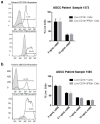Folate Receptor Beta as a Direct and Indirect Target for Antibody-Based Cancer Immunotherapy
- PMID: 34070369
- PMCID: PMC8197521
- DOI: 10.3390/ijms22115572
Folate Receptor Beta as a Direct and Indirect Target for Antibody-Based Cancer Immunotherapy
Abstract
Folate receptor beta (FRβ) is a folate binding receptor expressed on myeloid lineage hematopoietic cells. FRβ is commonly expressed at high levels on malignant blasts in patients with acute myeloid leukemia (AML), as well as on M2 polarized tumor-associated macrophages (TAMs) in the tumor microenvironment of many solid tumors. Therefore, FRβ is a potential target for both direct and indirect cancer therapy. We demonstrate that FRβ is expressed in both AML cell lines and patient-derived AML samples and that a high-affinity monoclonal antibody against FRβ (m909) has the ability to cause dose- and expression-dependent ADCC against these cells in vitro. Importantly, we find that administration of m909 has a significant impact on tumor growth in a humanized mouse model of AML. Surprisingly, m909 functions in vivo with and without the infusion of human NK cells as mediators of ADCC, suggesting potential involvement of mouse macrophages as effector cells. We also found that TAMs from primary ovarian ascites samples expressed appreciable levels of FRβ and that m909 has the ability to cause ADCC in these samples. These results indicate that the targeting of FRβ using m909 has the potential to limit the outgrowth of AML in vitro and in vivo. Additionally, m909 causes cytotoxicity to TAMs in the tumor microenvironment of ovarian cancer warranting further investigation of m909 and its derivatives as therapeutic agents in patients with FRβ-expressing cancers.
Keywords: acute myeloid leukemia; folate receptor beta; ovarian cancer; tumor-associated macrophages.
Conflict of interest statement
Daniel J. Powell holds patents in the area of anti-FRβ CAR T cell therapy. No other authors have any conflicts of interest to disclose.
Figures







References
-
- Coney L.R., Tomassetti A., Carayannopoulos L., Frasca V., Kamen B.A., Colnaghi M.I., Zurawski V.R., Jr. Cloning of a tumor-associated antigen: MOv18 and MOv19 antibodies recognize a folate-binding protein. Cancer Res. 1991;51:6125–6132. - PubMed
MeSH terms
Substances
LinkOut - more resources
Full Text Sources
Medical

